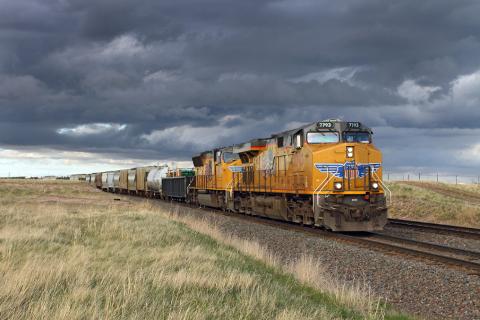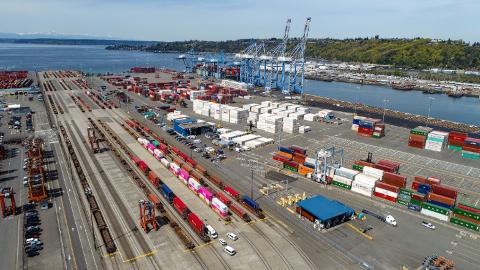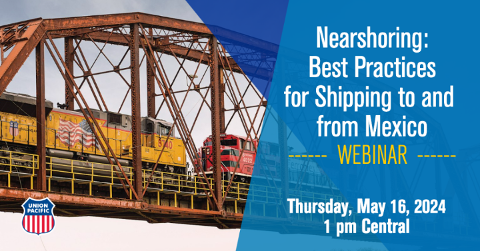When a U.S. shipment crosses the border into Mexico, how do you make sure it arrives safely at its destination? And when a shipment comes into the U.S. from Mexico, how do you make certain unauthorized cargo isn’t coming with it? Those answers depend, in part, on what shipping mode a company uses. While trucks can be susceptible to theft and illegal cargo, it turns out railroads take some very special measures to ensure shipments stay safe and only carry authorized goods from origin to destination.
We sat down with Jim Parker, Sr. Manager of Division Police Operations at Union Pacific Railroad, to talk about the steps railroads take to keep shipments moving safely to their destinations.
Who Keeps Rail Shipments Safe?

Customs Border Patrol Building
One thing most people don’t know is that railroads have their very own police forces. At Union Pacific, shipments are protected and monitored by the UP Police, the railroad’s own highly-trained, commissioned police force. It’s their job to ensure all Union Pacific customers’ commodities are secure and arrive to their destination without being compromised in any way.
Jim Parker is one of those special agents. He’s in charge of all railroad police operations within the Union Pacific Police Department’s Tucson division, which oversees the states of Nevada, Utah, Arizona, New Mexico, and the western portion of Texas. “We take up-front inspection measures as trains enter the U.S., and we have inspection measures as they travel throughout the U.S. in the 23 states in which UP operates,” he said. “On a daily basis, UP police are committed to inspecting and monitoring all trains that are operating within the system.”
How do railroad police differ from local or federal police? Union Pacific police are specially trained to:
- investigate criminal matters on or related to railroad property
- oversee security measures related to national rail infrastructure
- inspect and monitor national military shipments
- keep local and federal entities aware of reportable incidents regulated by federal standards regarding suspicious incidents on railroads
“The big difference between us and local authorities is that they are not obligated to meet any of these requirements or specialties,” Parker said. The UP police force also has a much larger area to police than local authorities. “Our sworn special agents all have law enforcement authority across state lines within the 23 states in which Union Pacific operates due to the fact that many of our criminal investigations or specialized requirements will cross over from one state to another.”
Because the territory they police is so large, Union Pacific’s police force also coordinates security efforts with a number of agencies, including U.S. Customs and Border Protection (CBP), the U.S. Coast Guard, the Federal Bureau of Investigation, the Central Intelligence Agency, the Department of Homeland Security and the Transportation Security Administration. “We have a good partnership with local and federal law enforcement entities because usually our criminal or security issues ultimately affect each other’s jurisdiction, so we have a mutual goal to solve the issue,” Parker said.
How Do Railroads Keep Shipments Safe from Theft?
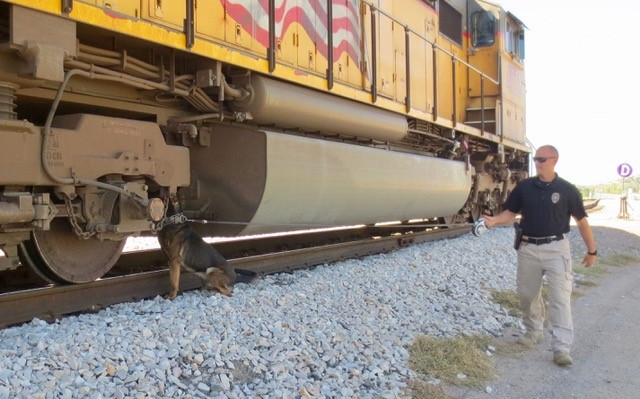
A Union Pacific special agent assisted by a police K9 performs a physical inspection at the border.
No matter where a company is shipping a product, they want to know it will be safe for the duration of the trip, as theft can be both costly to the bottom line and damaging to customer relationships. Railroad police help ensure this doesn’t happen.
At Union Pacific, a STAR Team (Strategic Temporary Agent Response Team), which is made of special agents within the system, will escort trains through known high-crime areas and will make arrests if a theft occurs. They also rely on specialized technology to prevent theft. For instance, thermal mobile cameras are strategically staged in known crime areas and, using their smart technology equipment, will notify UP Police agents when someone enters the camera’s view and is compromising a customer’s container.
Although railroads take many measures to prevent theft, occasionally one will occur. Railroad police handle these incidents, too. “If the crime occurs in the U.S., a field special agent is assigned to investigate the incident and document it within the UP Police report database system, which will send a notification to the customer by e-mail that the container has been compromised and is being investigated by the UP police,” Parker said. “If it occurs after it crossed the border, then the train has been transferred to a foreign railroad and their security or law enforcement group will investigate the crime, as UP police have no jurisdiction of the train or commodity outside the U.S. or our 23 states.”
How do Railroads Prevent Contraband from Crossing the Border?

Railcar Inspection Portal views
Railroad police also take special measures to make sure nothing illegal crosses the border in a rail car. Union Pacific has a special agent assigned to each border crossing, and these agents usually have a K9 partner. These inspection sites have their own buildings, high-security fencing, cameras and lighting to keep rail cars safe. They also leverage technology to detect unauthorized cargo and passengers: a Railcar Inspection Portal (RIP), which instantly provides a 360-degree view of the outside of rail cars passing through U.S.-Mexico crossings, and VACIS, which takes an x-ray of the contents of a rail car.
Parker said there are many levels of border procedures regarding security measures on the commodities that enter or leave the U.S.:
- All train consists, which include shipper, receiver and travel route information, go through a thorough inspection with Customs Border Patrol (CBP) prior to being allowed to enter the U.S.
- Once CBP has vetted the train consist, the train will enter the U.S. and will first go through an x-ray portal called VACIS, which x-rays each individual rail car for anomalies inside the rail cars.
- The train will then travel through the Railcar Inspection Portal (RIP), which takes a 360-degree image of each rail car looking for anomalies on the outside of the rail car.
- Next, the train will pull into an inspection zone that is fenced with high security fencing and has cameras and lights covering the entire zone.
- Here, Customs Border Patrol staff and UP police walk the train together and inspect the parked train with narcotics-trained detection dogs.
“Only after all these security measures are met will the train leave the secure inspection zone and proceed into the U.S. to its destination,” Parker said.
But what happens if something suspicious is identified on a rail car? That particular rail car will be isolated from the train and secured by CBP staff so contraband can be removed and seized. In these instances, the railroad is proactive about communicating with the affected customer and keeping the shipment moving to its destination. “Once the contraband is seized and removed from the rail car it is then released to go to the consignee [the party who ultimately receives the shipment] for the commodity to be unloaded. This usually happens with in a 24 to 48 hour period.” Parker said. “It’s typically a minor delay to the shipment.”
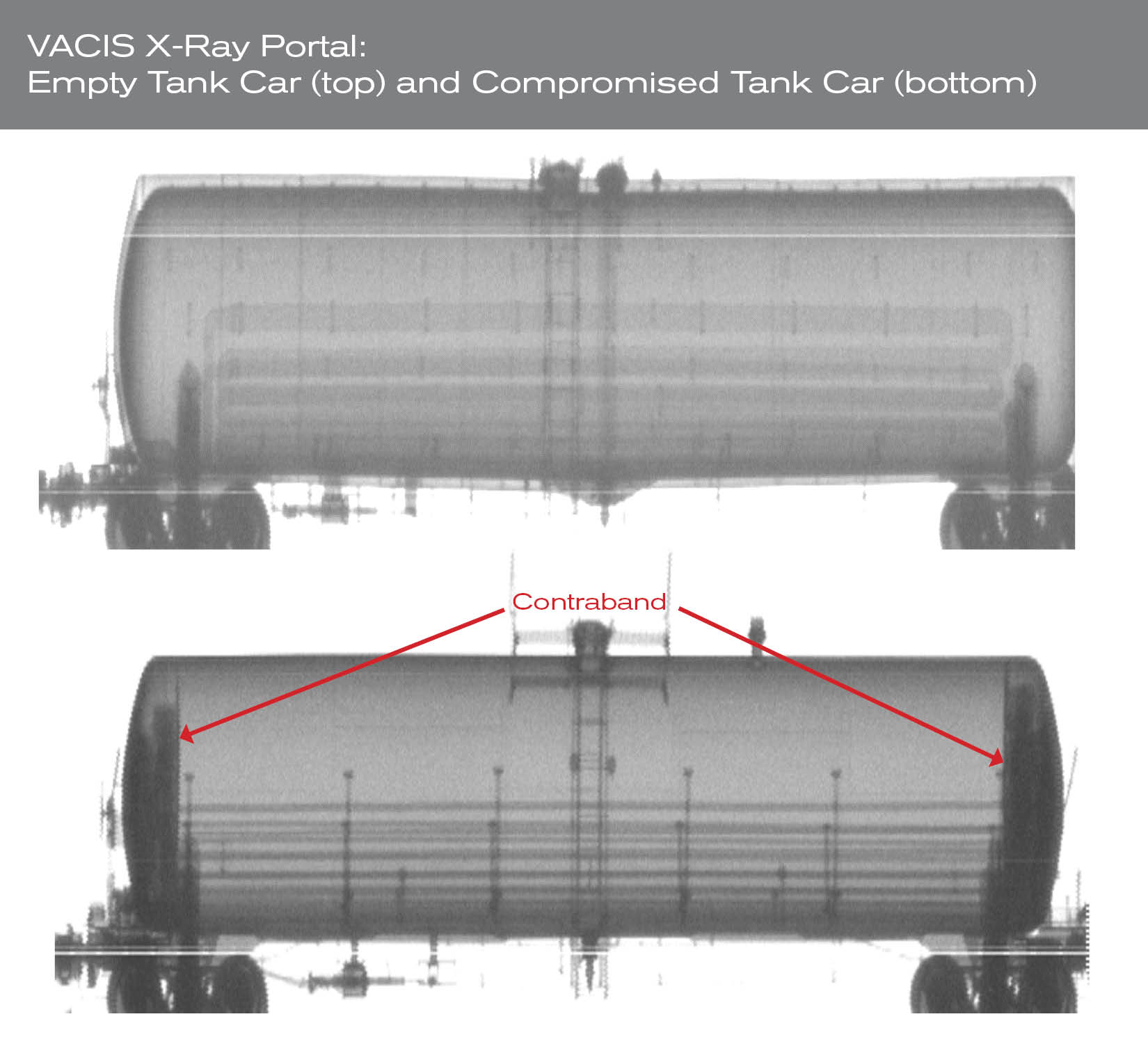
VACIS x-rays
What About Cybersecurity?
Technology is an important part of operating the railroad, so both physical and cybersecurity are important. In 1999, the freight rail industry established the Rail Information Security Committee in anticipation of the expanding role of information technology in business and operations. Then, following the September 11, 2001 terrorist attacks, railroads came together to assess security risks and produce a unified security plan with the goal of detecting and preventing terrorism. The resulting industry-wide security plan, which accounts for both physical and cyber security measures, allows the rail industry and its security partners to evaluate and respond to threats and address security concerns in real-time.
In order to protect the rail network 24/7, freight railroads and their security partners participate in an annual industry-wide exercise that simulates physical and cyber threats to evaluate preparedness and enhance procedures. Railroads have also participated in hundreds of security preparedness exercises with local police and emergency responders as well as U.S. and Canadian government departments and agencies.
Railroads look beyond their own operations as well, reviewing non-rail incidents happening around the world to better understand how illicit activities are planned and executed. This allows them to adjust plans and take additional security measures as needed. A dedicated industry alert network also disseminates timely security information to U.S. freight and passenger railroads almost daily to keep the U.S. rail network safe.
Which Is Safer: Trucks or Trains?
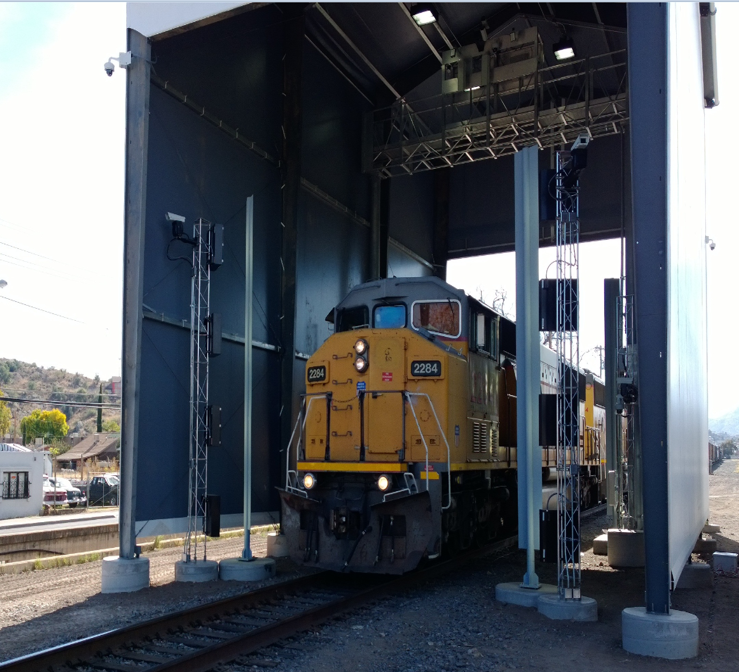
Nogales Rail Inspection Portal
When it comes to the way in which products are secured in a container or rail car, Parker said trucks and trains are fairly similar. But beyond that, trains have several advantages. “The difference is the railroad has a sworn and authorized police department to protect and monitor customers’ shipments,” he said. “No trucking group to my knowledge has a police department solely dedicated to securing commodities the way Union Pacific does.”
Beyond the police force, Parker said the number of stops trucks make compared to trains increases the likelihood of theft. “The railroad moves up to 300 to 400 containers at time, and it is difficult to compromise these containers while the trains are traveling,” he said. “Trucks, on the other hand, can only travel a minimum amount of time, typically about 12 hours. After that time, they must stop to rest for a mandatory amount time due to hours of service regulations before being allowed to continue to travel. This gives the truck commodities an opportunity to be compromised.”
For Parker, trains have the safety advantage. “Ultimately, moving that much freight that many miles on a continuous basis without stopping mitigates the opportunity for theft,” he explained.
What Can Shippers Do to Keep Their Products Safe?
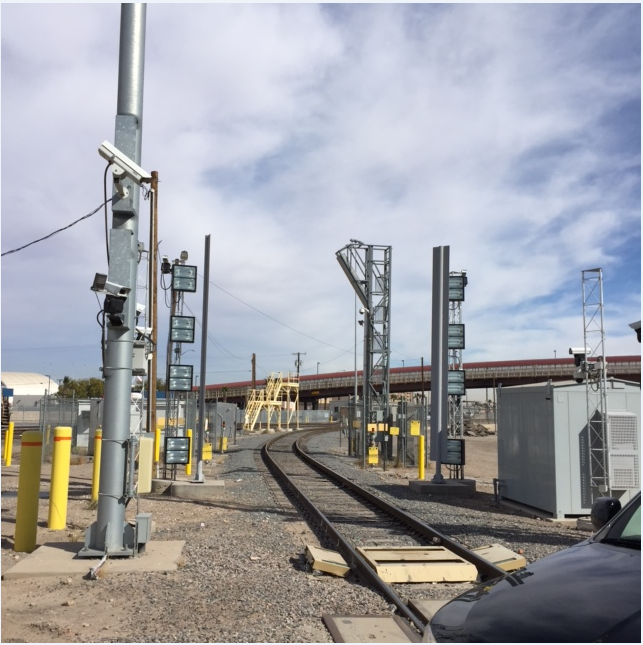
Rail Inspection Portal and VACIS at an entry yard.
While railroads do a lot to keep shipments safe, shippers can do their part, too. “There are always security measures customers can take to help mitigate theft or help determine where a theft occurred,” Parker said. “There are mechanisms which secure container doors better than the standard hasp and bolt and there are smart technology devices that can alert the customer if the door is open while in transit, which they then can use to notify UP police that a theft is in progress.”
Learn More
Want to learn more about shipment safety or shipping products across the border? Get in touch. We’d be happy to answer your questions.
Related Articles




